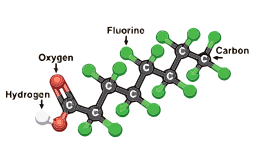Per- and polyfluorinated substances (PFAS), known as "forever chemicals," have long been utilized in various consumer products due to their exceptional properties.
However, the challenge lies in effectively treating or eliminating PFAS once they enter the environment or water supply. This blog will focus on the technological advancements in removing PFAS and perfluorooctanoic acids (PFOAs) from water sources. By exploring different treatment methods, such as activated carbon absorption, ion exchange resins, and reverse osmosis, and simply avoiding PFOA and PFOS, we can better understand the available options for mitigating these persistent chemicals in water.
 Activated Carbon Absorption
Activated Carbon Absorption
One of the earliest technologies employed for PFAS removal is activated carbon absorption. This method involves the use of specially treated carbon materials that effectively adsorb PFAS compounds from water sources. The activated carbon's large surface area and porous structure allow it to trap and retain PFAS molecules. This technology has proven effective in removing PFAS, including PFOAs, from drinking water and environmental sources. However, periodic treatment and regeneration of the activated carbon are necessary to maintain its efficacy.
Ion Exchange Resins
Ion exchange resins have emerged as a promising treatment method for removing PFAS compounds. These resins possess functional groups that selectively bind with PFAS molecules, effectively removing them from water. The resins capture the PFAS contaminants through an exchange process, allowing for their subsequent disposal. This technology has gained popularity due to its ability to target specific PFAS compounds, such as PFOS. While ion exchange resins offer effective removal capabilities, periodic regeneration or replacement of the resin is required to ensure continued performance.
Reverse Osmosis
Reverse osmosis (R.O.) utilizing high-pressure membranes has shown significant promise in removing PFAS from water sources. This process involves passing water through a semipermeable membrane, which effectively filters out PFAS compounds. Reverse osmosis has demonstrated an impressive removal rate of 80-90% for PFAS. However, it is essential to note that the R.O. process generates a concentrated waste stream that requires proper management and disposal. Despite this challenge, reverse osmosis has proven technically efficient and reliable in tackling PFAS in environmental contamination and its human health effects.
Selecting the Appropriate Technology
Choosing the most suitable PFAS removal technology requires a thorough analysis of various factors. Project location, business operations, and concentration levels are essential considerations. Activated carbon adsorption and ion exchange resins offer effective removal capabilities but require periodic treatment and regeneration. Reverse osmosis achieves high removal rates but generates a concentrated waste stream that necessitates proper handling. Assessing each technology's variables and associated costs helps engineers and owners understand the capital investment and ongoing operation and maintenance expenses. This informed approach ensures the selection of a treatment technology that effectively addresses PFAS contamination.
Partnering for Effective Solutions
At DeLoach Industries Inc., we understand the complexity of PFAS removal projects. Our experienced team reviews critical project data to assist customers and engineers in designing effective treatment systems. We can recommend the most suitable technology for removing PFAS and PFOAs by conducting comprehensive cost analyses. With over 50 years of expertise in water treatment, our professionals are committed to assisting customers worldwide in safeguarding water quality.
Advancements in PFAS removal technologies offer hope in combating the presence of "forever chemicals" in water sources and mitigating their harmful effects on human health and the environment. These technologies, including activated carbon absorption, ion exchange resins, and reverse osmosis, have demonstrated their effectiveness in removing PFAS and PFOAs, which are bioaccumulative toxicants and significant environmental contaminants. However, selecting the appropriate technology requires a careful evaluation of project variables, such as concentration levels and cost considerations. Through collaboration between industry experts, engineers, and stakeholders, we can collectively address the challenges posed by these persistent contaminants. By fostering a commitment to innovation and implementing effective treatment solutions, we can safeguard water quality, protect ecosystems, and ensure a healthier future for generations to come.




